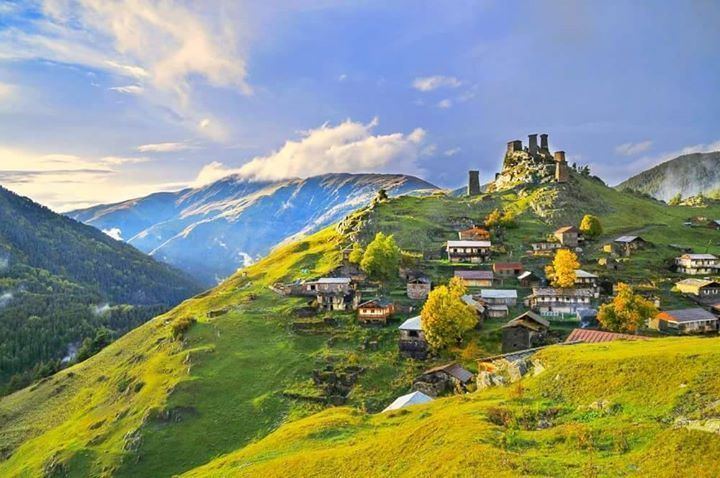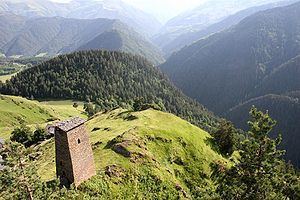Country Georgia Area 969 km² | Mkhare Kakheti Capital Omalo | |
 | ||
The way to tusheti georgia dangerous road abano pass 2994m
Tusheti (Georgian: თუშეთი) is an historic region in northeast Georgia.
Contents
- The way to tusheti georgia dangerous road abano pass 2994m
- Geography
- History
- Migration to Kakheti
- Culture
- Historical population figures
- References
Geography

Located on the northern slopes of the Greater Caucasus Mountains, Tusheti is bordered by the Russian republics of Chechnya and Dagestan to the north and east, respectively; and by the Georgian historic provinces Kakheti and Pshav-Khevsureti to the south and west, respectively. The population of the area is mainly ethnic Georgians called Tushs or Tushetians (Georgian: tushebi).

Historically, Tusheti comprised four mountain communities: the Tsova (living in the Tsova Gorge), the Gometsari (living along the banks of the Tushetis Alazani River), the Pirikiti (living along the banks of the Pirikitis Alazani River) and the Chaghma, living close to the confluence of the two rivers). Administratively speaking, Tusheti is now part of the raioni of Akhmeta, itself part of Georgia's eastern region of Kakheti. The largest village in Tusheti is Omalo.
History
The area is thought to have long been inhabited by the Tush, a subgroup of Georgians, which themselves divide into two groups- the Chaghma-Tush (Georgian name, used for Tush who speak the local Georgian dialect) and Tsova-Tush (Nakh-speaking Tush, better known as Bats or Batsbi). It is uncertain whether ethnic Georgians were there first or whether Bats were. There are two major theories on the origins of the Bats (with various variations).

One is that the Bats are the remnant of a larger Nakh-speaking people. Jaimoukha speculates that they may be descended from the Kakh, a historical people living in Kakheti and Tusheti (who apparently called themselves Kabatsa). However, the belief that the Kakh were originally Nakh is not widely held. The Georgian name for the Bats, the Tsova-Tush, may also (or instead) be linked to the Tsov, a historical Nakh people claimed by the Georgian historian Melikishvilli to have ruled over the Kingdom of Sophene in Urartu (called Tsobena in Georgian) who were apparently forcefully moved to the region around Erebuni, a region linked to Nakh peoples by place names and various historiography. However, theories linking the Bats to Transcaucasian peoples are not universally accepted (see below).

The second theory has it that the Batsbi crossed the Greater Caucasus range from Ingusheti in the seventeenth century and eventually settled in Tusheti, and that they are therefore a tribe of Ingush origin which was Christianized and "Georgianized" over the centuries.

King Levan of Kakheti (1520–1574) apparently granted the Bats official ownership of the lands in the Alvani Valley in exchange for their military service. Bats-speaking inhabitants of Tusheti are known to the local Georgians as the Tsova-Tushs, they have a high degree of assimilation and are typically bilingual using both Georgian and their own Bats languages. Nowadays, Bats is spoken only in a village Zemo Alvani. Anthropological studies on the Tsova-Tush found them to be somewhere in between the Chechen-origin Kists and the Chaghma-Tush of the region, but significantly closer to the Chaghma-Tush.
The Bats have considered themselves Georgian by nation for a long period of time, and have been speaking Georgian for a while as well. The process of assimilation of the Bats continues, but many Bats have held on to their language and spoken Georgian as well, accounting for the massive Georgian influence on their language. They are Georgian Orthodox Christians.
Pagan Georgians from Pkhovi took refuge in the uninhabited mountains during their rebellion against Christianization implemented by the Iberian king Mirian III in the 330s. Subsequently, they were forcibly converted to Christianity and subdued by the Georgian kings.
Regarding the relationship between the Nakh (Tsova) and Georgian (Chaghma) Tushians, the "Red Book", states the following:
For centuries there have been two communities next to each other in Tusheti, one speaking the Nakh language, the other Old Georgian. The general name for them is tush, according to their language either Tsova- or Chagma-Tushian. They formed one single material and intellectual unit with Old Georgian elements prevailing.
After the collapse of the unified Georgian monarchy, Tusheti came under the rule of Kakhetian kings in the fifteenth century.
During the German invasion of Soviet Union, a minor anti-Soviet revolt took place in the area in 1942-1943, seemingly linked to the similar but more large-scale events in the neighbouring Ingushetia.
Migration to Kakheti
Many Tush families began to move southwards from Tusheti during the first half of the nineteenth century and settled in the low-lying fields of Alvan at the western end of Kakheti.
(Alvan had already belonged to the Tush as a wintering-ground for their flocks for centuries; it was bequeathed to them in the seventeenth century in recognition of their valuable assistance in defeating a Persian army at the Battle of Bakhtrioni in 1659: Like a rushing stream did the Toushines make their way into the fortress, while the first rays of the rising sun were falling upon the grim old fortifications. The Tartars, half asleep, ran out into a field, but in vain for now they were met by the Pchaves and Khevsoures, who had ventured out from the gorge of Pankisse. The Tartars, surrounded on all sides, were exterminated to the last.)
The first to move were the Bats people following the destruction of one of their most important villages by a landslide in c.1830 and an outbreak of the plague. The Tush of the Chaghma, Pirikiti and Gometsari communities followed later. Many of these families practiced a semi-nomadic way of life, the men spending the summer with the flocks of sheep high up in the mountains between April and October, and wintering their flocks in Kakheti.
Culture
Traditionally, the Tushs are sheep herders. Tushetian Gouda (cheese) cheese and high quality wool was famous and was exported to Europe and Russia. Even today sheep and cattle breeding is the leading branch of the economy of highland Tusheti. The local shepherds spend the summer months in the highland areas of Tusheti but live in the lowland villages of Zemo Alvani and Kvemo Alvani in wintertime. Their customs and traditions are similar to those of other eastern Georgian mountaineers (see Khevsureti).
One of the most ecologically unspoiled regions in the Caucasus, Tusheti is a popular mountain-trekking venue.
Pork is tabooed in Tusheti. Farmers will not raise pigs and travelers are usually advised to not bring any pork into the region. Locals will however eat pork themselves when not in Tusheti.
Historical population figures
Figures from the Russian imperial census of 1873 given in Dr. Gustav Radde's Die Chews'uren und ihr Land — ein monographischer Versuch untersucht im Sommer 1876 (published by Cassel in 1878) divide the villages of Tusheti into eight communities:
1873 TOTAL: 50 villages, 1,131 households, consisting of 2,548 men and 2,555 women, in all 5,103 souls.
Note: The Indurta and Sagirta communities were home to the Bats people.
